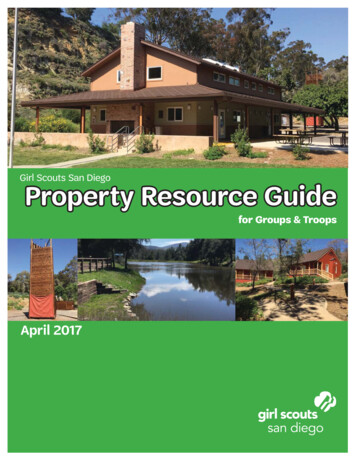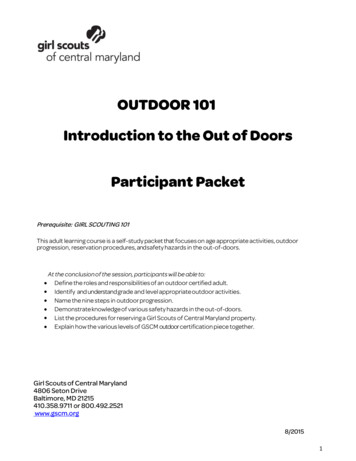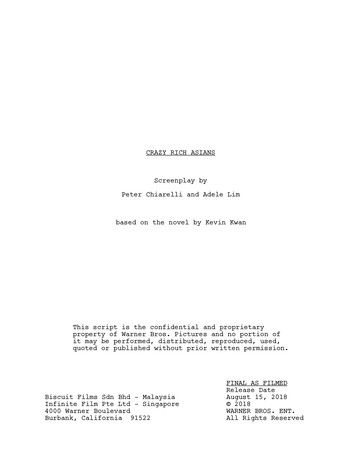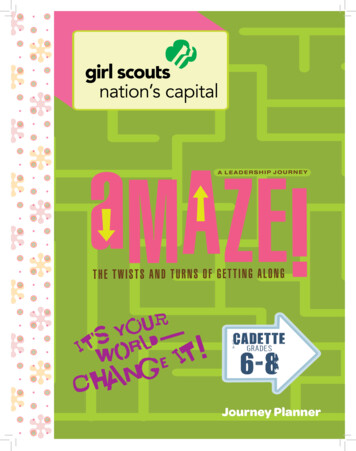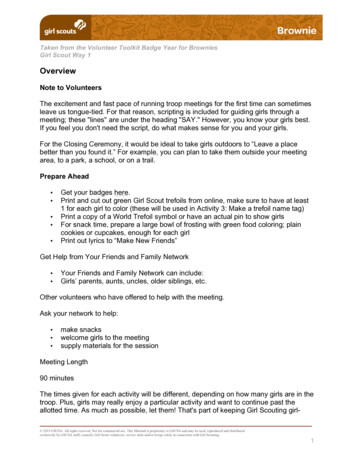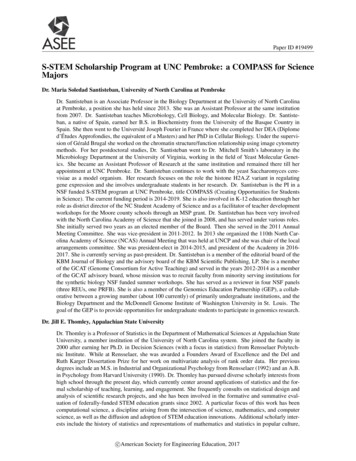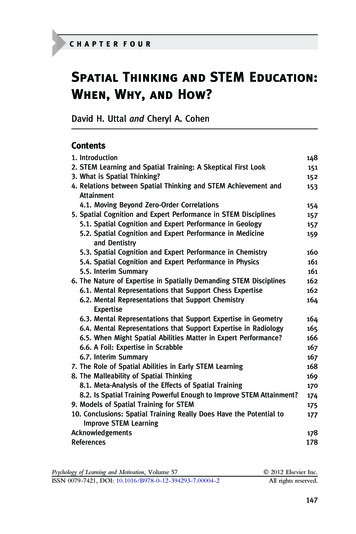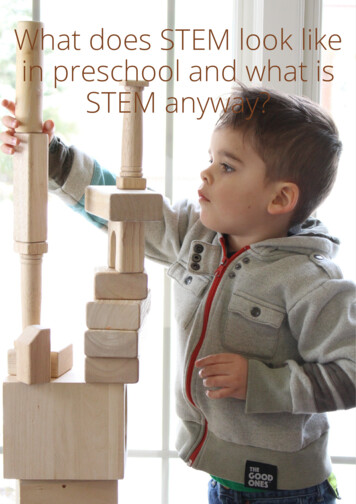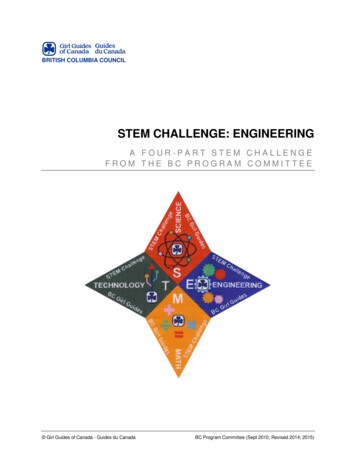
Transcription
BRITISH COLUMBIA COUNCILSTEM CHALLENGE: ENGINEERINGA FOUR-PART STEM CHALLENGEFROM THE BC PROGRAM COMMITTEE Girl Guides of Canada - Guides du CanadaBC Program Committee (Sept 2010; Revised 2014; 2015)
STEM CHALLENGE: ENGINEERINGCopyright 2014, 2015 Girl Guides of Canada-Guides du Canada, British Columbia Council,1476 West 8th Avenue, Vancouver, British Columbia V6H 1E1Unless otherwise indicated in the text, reproduction of material is authorized for non-profitGuiding use within Canada, provided that each copy contains full acknowledgment of thesource. Any other reproduction, in whole or in part, in any form, or by any means, electronic ormechanical, without prior written consent of the British Columbia Council, is prohibited.BRITISH COLUMBIA COUNCIL Girl Guides of Canada - Guides du CanadaBC Program Committee (Sept 2010; Revised 2014; 2015)
STEM CHALLENGE: ENGINEERINGCONTENTSIntroduction to the STEM Challenge. 1Objectives . 1Outcomes . 1What is Engineering, Exactly? . 1Challenge Requirements . 2Program Connections . 3STEM Challenge: Engineering Tracking Sheet . 4Activities . 5Discover Engineering . 5Build a Shelter . 8Build a Solar Still . 9Egg Protectors . 11Bridge Building . 13Rockets . 15Coin Sorter . 18Build a Robot. 19Build a Light Bulb . 21Wind Energy Pinwheels . 23Solar Cooking. 24Go Fly a Kite . 25Paper Airplanes. 27Hoop Gliders . 29Reverse Engineering. 30Rubber Band Power . 31Build a Sail Car . 33Build a Mousetrap Car . 34Build a Boat or Raft . 35Build a Rollercoaster . 37Marshmallow Structures . 38Marshmallow Catapult. 39Kitchen Cookie Engineering . 41Program Connections. 43Sparks . 43Brownies . 43Guides . 43Pathfinders . 44Rangers . 44 Girl Guides of Canada - Guides du CanadaBC Program Committee (Sept 2010; Revised 2014; 2015)
STEM CHALLENGE: ENGINEERINGPage 1INTRODUCTION TO THE STEM CHALLENGEWelcome to the new, updated Science, Technology, Engineering and Math Challengefrom the BC Program Committee. This is a four-part challenge: one booklet, and oneribbon crest, for each of Science, Technology, Engineering and Math. Do just the partsthat interest you, or tackle all four and proudly display the complete crest on your campblanket.The STEM Challenge is an update of the Science in a Box and Girls ExploringTechnology (GET) challenges that were launched by the BC Program Committeeseveral years ago.As you work on the challenge, please remember: We'd love to hear from you! Pleasefeel free to let us know what activities you've done and what you thought of the STEMChallenge.Sincerely,The BC Program CommitteeObjectivesTo engage girls in engineering.To have fun while exploring the fields of engineering and applied science.OutcomesAt the completion of this challenge, girls will demonstrate an improved awareness ofand interest in:1. the concepts of civil engineering.2. the concepts of mechanical engineering.3. the concepts of electrical engineering.4. the concepts of chemical engineering.5. the engineering process.What is Engineering, Exactly?Scientists study the world as it is; engineers create the world that has never been.—Theodore von Kármán, aeronautical engineerMerriam-Webster defines engineering as "the application of science and mathematicsby which the properties of matter and the sources of energy in nature are made usefulto people". In other words, engineering is the process of making science useful.Scientists observe the natural world, develop theories about what they see, thenexperiment to try to prove (or disprove) their theories. Once the theories have been putthrough the wringer and have survived, engineers take the science and apply it to realworld problems—they make the science useful to people. Consequently, engineering isalso often referred to as applied science.There is plenty of overlap between pure science and engineering, and it isn't alwayseasy (or possible, or even desirable) to tell where one leaves off and the other begins.As a rule of thumb, you can look at it this way: If you are asking questions about whysomething is the way it is ("Why are cylinders so strong?" "Why do the planets appearto move through the sky?" "Why do baking soda and vinegar fizz when you mix them?"), Girl Guides of Canada - Guides du CanadaBC Program Committee (Sept 2010; Revised 2014; 2015)
STEM CHALLENGE: ENGINEERINGPage 2you're doing science. If you already know that something is the way it is and you'retrying to use that information to accomplish a goal ("Can I use a cylinder shape tosupport a bridge or building?" "What do I have to do to land a spaceship on Mars?""Can I use a baking-soda-and-vinegar-reaction to drive a model boat?"), it'sengineering.In this part of the STEM Challenge, you'll notice that many of the activities don't haveprecise step-by-step instructions telling you exactly how to do something. That'sbecause this part of the challenge is all about problem- solving: you have a problem youneed to solve or a goal you want to accomplish; figuring out how is up to you. Also, insome of these activities, you will have limited resources—as in any real engineering job,there is only so much material, money, and time; sometimes getting the job done withinthose constraints means making trade-offs and compromises. Be creative, beresourceful, be practical: be an engineer!Challenge RequirementsTo earn the ribbon crest for this part of the STEM Challenge, you need to completeactivities in order to earn “challenge credits”, depending on your branch of Guiding. Youcan select these activities from this booklet, or you can choose activities from theInternet, books or magazines, other Guiders or people in your community, or any otherresources. As long as the activities are challenging for your group and fit the objectivesof this part of the STEM Challenge, go ahead and use them. (And if you come acrosssomething really cool, please let us know so we can add it to any future STEM-relatedchallenges!)The “challenge credit” system is new – activities that require more time to complete willearn more credits than the quick activities. The number of challenge credits per activityis listed on the challenge tracking sheet. If you would like to complete an alternateactivity, which requires more time and in-depth study, you can use your judgment todetermine how many credits the activity should be worth.The Program Committee has produced a variety of program resources that includeSTEM activities. Look for these resources on the BC Girl Guides website: Science in a Box – Program tab Program Resources STEMEco-Pak Challenge – Program tab Challenges & Activities Provincial ChallengesCSI Challenge – Program tab Challenges & Activities Provincial ChallengesBranch-specific Instant Meeting booklets – Program tab Instant MeetingsFunFinder Program Resource – Program tab FunFinderTotal number ofcredits ults34555When you have fulfilled the requirements, complete the BC Crests Order Form foundon the BC Girl Guides website http://www.bc-girlguides.org/ (click on Program Challenges & Activities Provincial Challenges). Instructions on how to order the crestsare provided on the form. Girl Guides of Canada - Guides du CanadaBC Program Committee (Sept 2010; Revised 2014; 2015)
STEM CHALLENGE: ENGINEERINGPage 3Program ConnectionsEach activity in this booklet includes a list of program connections – areas of the girls'regular program that the STEM challenge meets the requirements for. These programconnections are intended as guidelines to help you fit the STEM challenge into yourregular program planning. In some cases, the challenge activity is very similar to anactivity in the program area; in other cases, the challenge activity could be used as analternative to activities mentioned in the program area. In all cases, remember that thegirls' program is intended to be flexible: if an activity meets the objectives of the programarea, and if it is interesting and challenging for the girls, by all means give them creditfor it as part of their program requirements.The lists of program connections are also not exhaustive. If you find another programarea that is covered by an activity in this booklet, don't hesitate to give the girls credit forit.You may notice that very few of the activities include explicit program connections forRangers. The Ranger program encourages in-depth exploration of topics of interest.Many of the activities in this booklet, on the other hand, are relatively short and simple— so that busy Guiders can easily incorporate them into unit meetings — and offer onlya very superficial taste of the subject matter. That makes it difficult to draw directconnections between these activities and the Ranger program. However, because theRanger program is also very flexible and self-directed, Rangers can certainly take anyof these activities and expand or combine them to meet the objectives of one of theprogram areas. Rangers who are working in units can also plan and lead any of theseactivities for younger girls. Girl Guides of Canada - Guides du CanadaBC Program Committee (Sept 2010; Revised 2014; 2015)
STEM CHALLENGE: ENGINEERINGPage 4STEM CHALLENGE: ENGINEERING TRACKING ults5Except where indicated, activities in this challenge are worth 1 credit each. Discover Engineering (first activity)Discover Engineering (second activity)Build a Shelter (S,B)Build a Solar StillEgg Protectors (2 credits)Bridge Building – with glue or tapeRockets – Balloon or PaperCoin Sorter (2 credits)Build a Robot: Imagination Robot (S,B)Build a Robot: NanoRover (2 credits)Build a Robot: Robotic Arm (2 credits)Build a Light BulbWind Energy PinwheelsSolar Cooking (2 credits) Go Fly a KitePaper AirplanesHoop GlidersReverse EngineeringRubber Band Power (2 credits)Build a Sail CarBuild a Mousetrap Car (2 credits) (P,R)Build an Aluminum Boat (1 credit) ORBuild a Raft (2 credits)Build a Rollercoaster (2 credits)Marshmallow StructuresMarshmallow CatapultKitchen Cookie Engineering (2 credits)Eco Pak Challenge ActivitiesThe following activities from the Eco Pak challenge are related to EnvironmentalEngineering, and may be applied to both challenges. The Great Cookie Extraction Dilution: A Pollution Solution Making Recycled Paper Oil Spill Plastic Bits ‘N Pieces Make an Air Pollution CollectorCSI Challenge ActivitiesThe following activities from the CSI challenge are related to Genetic Engineering, andmay be applied to both challenges. How Alike Are We? DNA Extraction Bar Code DNAOther Engineering ActivitiesAlternate activities that meet the objective of this challenge. Girl Guides of Canada - Guides du Canada BC Program Committee (Sept 2010; Revised 2014; 2015)
STEM CHALLENGE: ENGINEERINGPage 5ACTIVITIESDiscover EngineeringEngineering is a huge field. Engineers build bridges, airplanes and computers. Theywork in space programs and in medical technology. Spend some time getting to knowengineers and what they do.DirectionsChoose one of the following activities (or come up with your own) to learn aboutdifferent kinds of engineers, where they work and what they do. If several of theseactivities catch your interest, feel free to do more than one! You can count up to two ofthem towards the Engineering challenge.6. Find out about different types of engineering. A basic list can be found gineering. Complete the includedcrossword puzzle.7. Visit an engineer at work. Tour her workplace and find out what she does and howshe does it. If you're not sure where to find engineers at work, try these ideas: Construction sites/companiesUniversitiesIndustrial sites, such as factories, mines, sawmills, hydroelectric dams, etc.Forestry companiesMunicipal engineering departmentsLarge companies that might have a computer engineer as part of their IT staffTechnology companies8. Create a work of art that illustrates an engineering principle or shows what engineersdo. For example: Make a collage of photos from magazines showing engineers at work.Build a sculpture that uses simple machines, electronics, construction materialsor other engineering materials.Design a poster illustrating the work of a famous engineer (past or present). Forinformation about Canadian engineers and their accomplishments, check out theNational Engineering Month website at www.nem-mng.ca.9. Find a current news or magazine article about engineers and the work that they do,and share it with your group. What makes the article interesting to you?10. Watch a video or play a video game about engineers and the work they do. Forsome good online resources, check out the following link: Discover Engineering (www.discoverE.org): Website developed by the USNational Engineers Week Foundation. It has videos with good kid appeal andideas for follow-on activities.11. Take part in a National Engineering Month activity in your community. NationalEngineering Month is March, and you can find information on events on the NationalEngineering Month website (www.nem-mng.ca, and click Events on the menu). Girl Guides of Canada - Guides du CanadaBC Program Committee (Sept 2010; Revised 2014; 2015)
STEM CHALLENGE: ENGINEERINGPage 6Discover Engineering Crossword PuzzleThere are over 200 types of engineering.Discover some types of engineering with this puzzle.123456Word oleumstructuralAcross2. This type of engineer uses chemistry to design a range of different products, from food tocleaning products to explosives, and beyond!6. These engineers specialize in computer hardware and software.8. This type of engineer designs systems that work to prevent pollution.9. This type of engineer designs things like televisions and video games.14. Without this type of engineer, we wouldn’t have power in our homes!16. This type of engineer research and design airplanes and other flying equipment. Theydesigned, for example, the Canadarm on the space shuttle.Down1. This is one of the oldest types of engineering. They design roads, bridges, railways,buildings, etc.3. This type of engineer designs vehicles.4. This type of engineer designs machines, engines and other equipment that includes movingparts.5. This type of engineer specializes in extracting metal from ore.7. This type of engineer focuses on extracting minerals from the Earth’s crust.10. One thing this type of engineer designs is tall skyscraper buildings.11. These engineers explore, recover and develop methods to process oil and gas.12. This type of engineering combines engineering with human anatomy.13. An engineer has a university .15. Engineering is also called science. Girl Guides of Canada - Guides du CanadaBC Program Committee (Sept 2010; Revised 2014; 2015)
STEM CHALLENGE: ENGINEERINGPage 7Discover Engineering Crossword PuzzleAnswer Key15CMI8 E N V32 C H E M I4C A LUIM7C O M P U T E RR O N M E N T A LICHTIONALMI10ANSN11 GTIL9 E L E C T R O N ILTCU12I13PRCRBVDEUAGI14 E L E C T R IIO15GRTCMAROU16 A E R O S P A C ELREALALDPEILUCIMAELDC A LProgram ConnectionsSparks:Brownies:Guides:In My Community Keeper; Exploring and Experimenting KeeperKey to My Community; Key to STEMDiscovering You: Discovering What's Important to You; Engineeringbadge; Career Awareness badge; Science badgePathfinders: Your Dream Career module; Everything Comes from STEM moduleRangers:Your Future (Gender Roles; Canadian Ingenuity; Techno Jobs) Girl Guides of Canada - Guides du CanadaBC Program Committee (Sept 2010; Revised 2014; 2015)
STEM CHALLENGE: ENGINEERINGPage 8Build a ShelterThis activity is quite simple, and is best for Sparks or Brownies. Try one (or more) of theother “Build” activities for older girls.Structural engineers design and build structures. Your challenge is to build a selfsupporting structure that will protect a small stuffed animal from the weather.Directions1. Explain to the girls that one type of engineer is astructural engineer and that they design structures.Can they name some structures? (i.e. house,school, library, hospital, any building!)2. Tell the girls that they are going to be structuralengineers today and design a structure to protecttheir small stuffed animal from the weather.3. Let the girls use their imaginations to build anddecorate their structures.4. When everyone is finished, have them share theirstructural creations and explain how it protectstheir animal.5. You could test the structures by shining a brightlight at it (simulating the sun) or blowing on it(simulating the wind).Supplies ask each girl to bring asmall stuffed animalfrom home, or provide asmall toy for each girl tobuild a structure for variety of buildingmaterials, such aconstruction paper,cardboard tissue tubes,popsicle sticks, drinkingstraws, toothpicks etc. tape markers or pencilcrayonsProgram ConnectionsSparks:Brownies:Exploring and Experimenting KeeperKey to STEM; Key to Camping; Be Aware interest badge Girl Guides of Canada - Guides du CanadaBC Program Committee (Sept 2010; Revised 2014; 2015)
STEM CHALLENGE: ENGINEERINGPage 9Build a Solar StillClean water is essential for human health, and in many places of the world it isextremely scarce. If you live in a place where there isn't enough rainfall to provide freshwater for everyone's needs, what do you do? Desalination projects, which remove thesalt and other minerals from seawater to make it safe for human consumption andirrigation, are one way of easing the shortage. (Large-scale desalination projects arealso expensive and consume large amounts of energy, though.) Build your ownminiature, renewable-energy desalination project in this activity: a solar still that distillsfresh water from salt water.Directions1. Set the glass in the middle of the bowl. If it sticksup higher than the rim of the bowl, find a shorterglass.2. If you are using flexible plastic tubing, place oneend in the glass, making sure it goes all the waydown to the bottom. Lay the other end over theedge of the bowl; tape it in place if need be.3. Pour salt water into the bowl so that it comesabout half way up the glass. Be careful not to getsalt water into the cup.4. Put plastic wrap over the top of the bowl,covering it completely. Tape it in place if youthink it might not stick very well. The plastic wrapshould be just a little bit loose across the top ofthe bowl, not stretched absolutely tight.5. Gently set the pebble on the plastic, directly overthe glass.6. Place your still in a warm, sunny location andleave it alone. After several hours, you shouldsee that some water is collected in the glass.Taste it. Is it salty or fresh?Note: If you have used plastic tubing or a straw,you can sip your distilled water without takingyour still apart. Otherwise, just remove the plasticwrap and take the glass out to taste the water.ExplanationThe sun warms up the water in the bowl and makesit evaporate. The evaporated water collects on theunderside of the plastic wrap and runs downhill(thanks to the pebble weighing down the middle ofthe plastic) into the glass. This water is fresh, notsalty, because the salts and other minerals in the Girl Guides of Canada - Guides du CanadaSupplies large mixing bowl drinking glass (shorterthan the depth of thebowl) flexible plastic tubing(optional)Note: Use only cleanplastic tubing for thisactivity—don't usesomething you've found inthe garage. If you like, youcan substitute a couple ofdrinking straws stucktogether to make a reallylong straw. water mixed with tablesaltNote: Mix enough salt intothe water so that you canreally taste it when you puta drop on your tongue. Donot drink salt water.Note: Do not use road saltfor this activity; it is notsafe for consumption. plastic wrap masking tape small pebble or similarobjectBC Program Committee (Sept 2010; Revised 2014; 2015)
STEM CHALLENGE: ENGINEERINGPage 10salt water don't evaporate – they are left behind in the bowl. If you leave your stillundisturbed long enough, you might see some crusty white material collecting along theedge of the water. That's the salt that's left behind.This kind of still can also be used to purify brackish water to make it safe for drinking.And, unlike large-scale commercial desalination plants, it does not require lots of energyfrom fossil fuels or nuclear sources.Program ConnectionsSparks:In My Community Keeper (Clean Water); Exploring and ExperimentingKeeperBrownies:Key to STEM; Key to the Living World; Water, Water Everywhere interestbadgeGuides:Beyond You: Try New Things; Water badge; Physics badge; SciencebadgePathfinders: Survivor Girl; Everything Comes from STEMRangers:Use this as part of a larger project on clean water (Environment,Outdoors and Camping: Falling from the Sky; Water, Water Everywhere) Girl Guides of Canada - Guides du CanadaBC Program Committee (Sept 2010; Revised 2014; 2015)
STEM CHALLENGE: ENGINEERINGPage 11Egg ProtectorsCan you keep an egg from breaking when you drop it? Thinking of ways to protect anegg is similar to what engineers had to think about when they designed things likebicycle helmets to protect people from getting hurt. Are there other things that helpabsorb impacts and protect things from injury? Some examples may include hockeypads, air bags, car bumpers, etc.This is a challenging activity that may take some time. It is great for camps, when youhave a little more time to design and build an egg-protector.When you are selecting a location for this activity, keep an eye on safety. Having girlsreach over a railing on a low balcony to drop their eggs is probably okay; letting themdangle off the edge of a shed roof is not. Do not hang out windows. Also, make surethe area you choose can be easily cleaned up.CAUTION: Raw eggs may contain microorganisms that are harmful. Make sure towash your hands with soap after handling the eggs.Directions1. Set up the “Egg Launch Zone” prior to the activity.Spread out several garbage bags to mark the egglaunch zone and for easy cleanup if some eggs donot survive the fall.2. Have the girls work in pairs or in teams of 3-4.Have them brainstorm some possible designs.3. Use whatever materials you can find to build acontraption that will keep your egg from breakingwhen you drop it from a raised location (has to beat least 3 metres above the ground).4. If you have enough eggs, experiment to see if youcan improve your design, or come up with a new,completely different design.5. Alternatively, use a plastic Easter egg to work withand test your egg protector before using a real rawegg.Supplies raw egg plastic Easter egg a variety of foundmaterials (paper, tape,toothpicks, straws,popsicle sticks, pipecleaners, streamers,packing beads,feathers) plastic garbage bags raised location, like alow balcony or a flightof steps, in an area thatcan be easily cleanedup6. When everyone is ready for the Egg Launch, havethe girls vote on the “most creative or innovative”or the “prettiest” egg protector. Then proceed on with the egg launch.What else you can do with this:If raw eggs will be too challenging (or too messy), hard-boil them first. As a bonus, youmay be able to salvage some of them afterwards for egg salad!You can also use small water balloons for this experiment, instead of eggs. Girl Guides of Canada - Guides du CanadaBC Program Committee (Sept 2010; Revised 2014; 2015)
STEM CHALLENGE: ENGINEERINGExplanationPage 12The egg in the egg protector held 3 metres above the ground has gravitational potentialenergy stored in it. When the egg is released, its potential energy (stored energy) isconverted into kinetic energy (motion energy).Program ConnectionsSparks:Brownies:Guides:Exploring and Experimenting KeeperKey to STEM; Team Together interest badgeBeyond You: Try New Things; Engineering badge; Physics badge;Science badgePathfinders: Everything Comes from STEM module Girl Guides of Canada - Guides du CanadaBC Program Committee (Sept 2010; Revised 2014; 2015)
STEM CHALLENGE: ENGINEERINGPage 13Bridge BuildingUse simple materials to build a bridge and test its strength.If you don't have a glue gun, you can use white glue or wood glue to build your bridge,but it takes a lot longer. Glue-gun glue dries almost instantly; white glue or wood gluetakes quite a while. You might need to build your bridge in stages, letting each stage drybefore you add another.Option 1: Directions – with glue1. Draw two lines about 15 cm apart down the middleof the cardboard. This represents a river.Supplies2. Use toothpicks and glue to build a bridge acrossthe river. Your bridge must be at least 5 cm high atthe middle of the river, and you cannot use anysupports in the middle of the river—only on thesides. large piece of3. Let your bridge dry completely, then set the papercup on the middle of it. Add coins or marbles to thecup. glue gun and glue sticks small paper cup coins, marbles or other4. How many can your bridge support before itcollapses?cardboard pencil or pen flat toothpicks or craftstickssmall objectsNote: If you don't want to break your bridge, stopadding coins when it starts to bend, and take the weight off right away.5. Encourage the girls to use the engineering process:1. Design 2. Build 3. Test 4. Refine/ChangeOption 2: Directions – with tape6. Use the materials to build a bridge that spans 5inches (the length of the index card), has aroadbed that is at least 1 ½ inches above theground, and no part of the 5 inch roadbed, orsupports directly under the roadbed, may touch theground.7. Once complete, bridges will be tested by applyingweight to the centre of the bridge until failure.Failure occurs when the roadbed touches theground.8. Encourage the girls to use the engineeringprocess:Supplies 2 index cards (3” x 5”)2 paper clipstapescissorsFor load testing: small paper cup coins, marbles or othersmall objects1. Design 2. Build 3. Test 4. Redesign/Change Girl Guides of Canada - Guides du CanadaBC Program Committee (Sept 2010; Revised 2014; 2015)
STEM CHALLENGE: ENGINEERINGExplanationPage 14Engineers build bridges with very strong m
To engage girls in engineering. To have fun while exploring the fields of engineering and applied science. Outcomes At the completion of this challenge, girls will demonstrate an improved awareness of and interest in: 1. the concepts of civil engineering. 2. the concepts of mechanical engineering. 3. the concepts of electrical engineering. 4.
